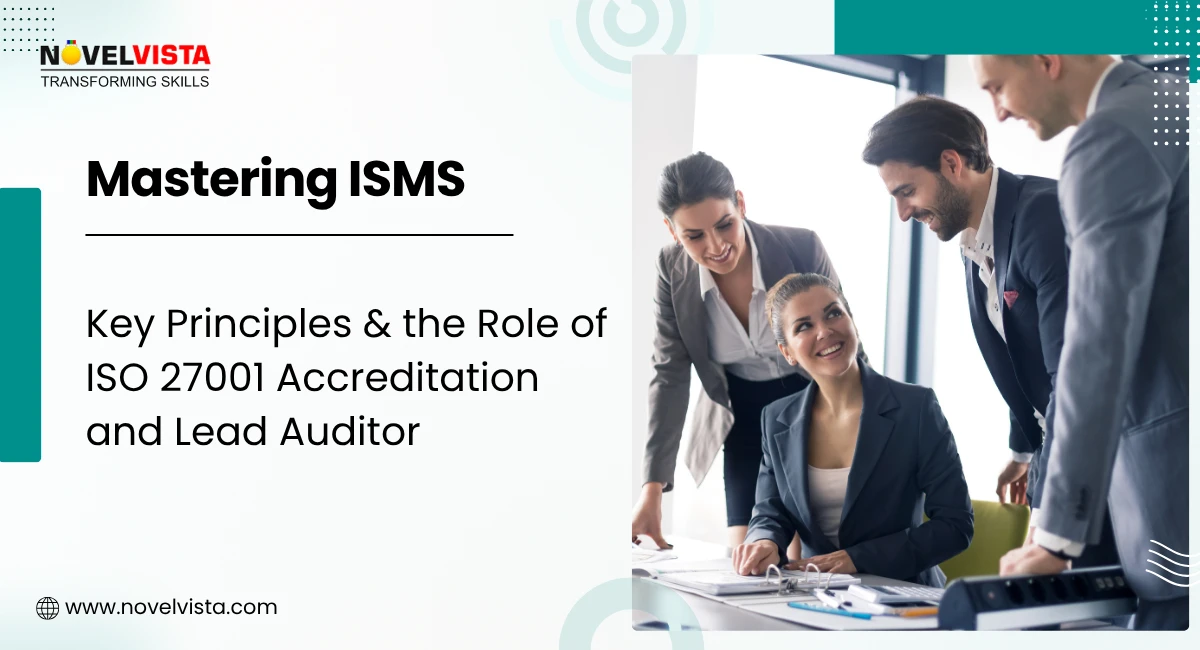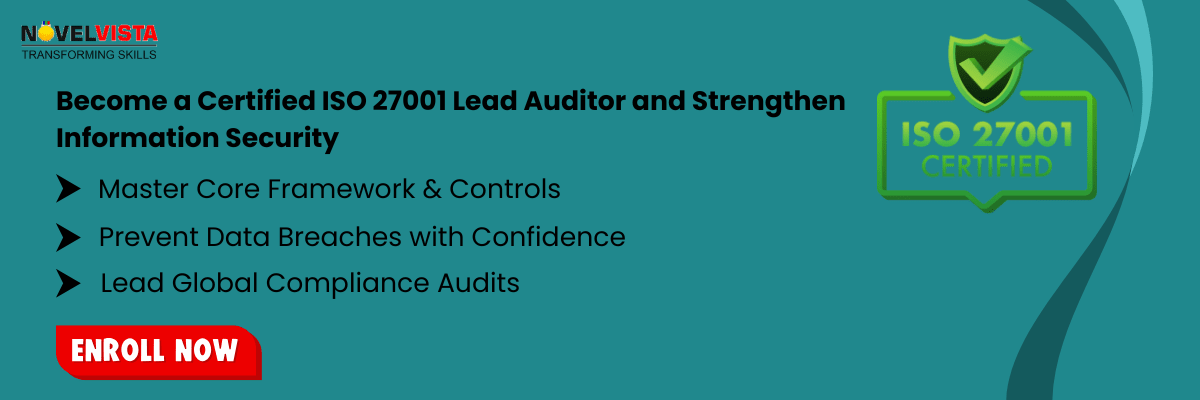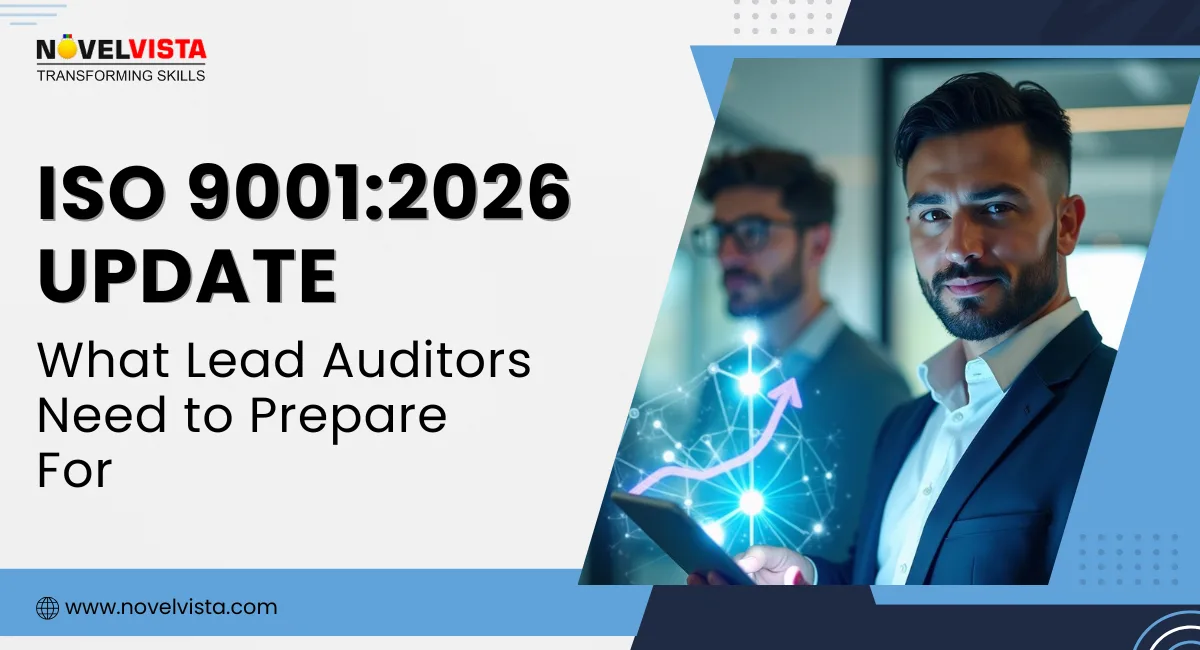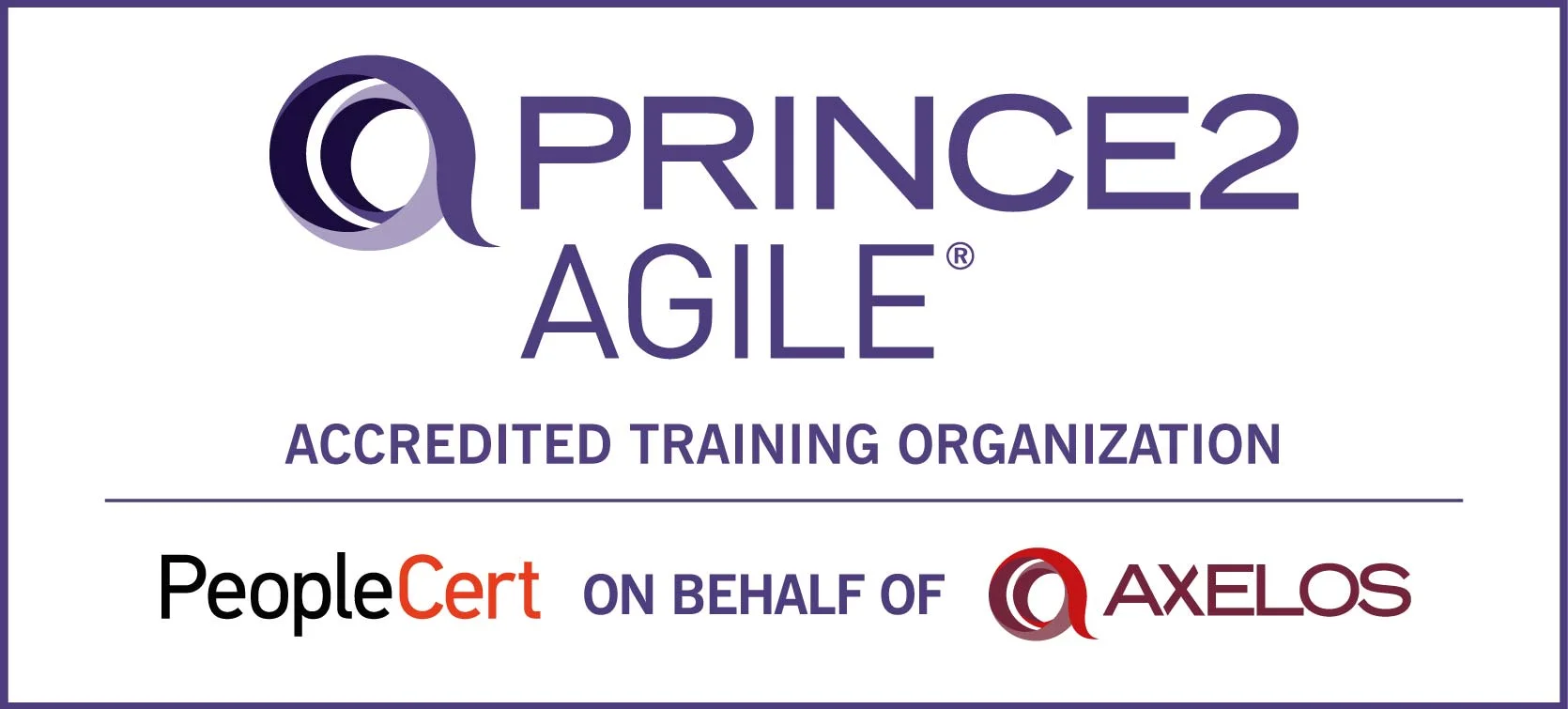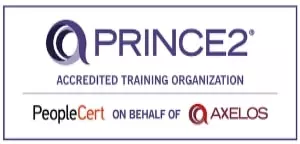- What is the ISO 27001 Standard?
- Key Elements of the ISO 27001 Framework
- Key Clauses and Controls of the ISO 27001 Framework
- How Does ISO 27001 Compare with SOC 2, HIPAA, and GDPR?
- Integration with Other Management Standards
- Implementation Challenges of the ISO 27001 Framework
- Benefits of ISO 27001 Accreditation
- Role and Pathway of ISO 27001 Lead Auditors
- Conclusion
- Next Step:
Firewalls and passwords alone don’t make you secure. What most organizations miss is a structured system, and that’s exactly what the ISO 27001 framework delivers. In a world where cyber threats evolve faster than most businesses can react, having just tools and policies isn’t enough. You need a framework that ties every part of your security, people, processes, and technology together under one strong, auditable system.
That’s where ISO 27001, the global standard for Information Security Management Systems (ISMS), comes in. It helps organizations systematically manage security risks, ensure compliance, and build trust with customers and partners. Whether you’re running a startup or managing enterprise infrastructure, ISO 27001 helps you turn security from a reaction into a well-oiled strategy.
This guide breaks down everything you need to know about the ISO 27001 framework, from its key elements and clauses to its controls, integration with other standards, and the role of Lead Auditors in keeping compliance running smoothly. Plus, don’t miss our downloadable ISO 27001 checklist PDF to help you get started on implementation right away.
What is the ISO 27001 Standard?
At its core, the ISO 27001 framework defines the requirements for creating, implementing, maintaining, and improving an Information Security Management System (ISMS). It’s not just about having security measures; it’s about having a systematic approach that identifies risks, manages them effectively, and continuously improves. Even more than 85% of organizations are now investing in structured ISMS programs like ISO 27001 to protect against cyber threats.
The standard applies to organizations of all types and sizes, from small consultancies to global corporations, because data protection isn’t industry-specific anymore; it’s universal. Whether your data is on the cloud, on-premises, or hybrid, ISO 27001 ensures it’s managed securely and consistently.
For a detailed exploration of ISO 27001 standards and scope, read our full ISO 27001 guide.
Key Elements of the ISO 27001 Framework
Let’s look at what makes the ISO 27001 framework so effective. It isn’t a one-time checklist; it’s a cycle of continuous improvement that keeps your organization secure and compliant.
1. Information Security Management System (ISMS): This is the heart of ISO 27001, a framework of policies, procedures, and technical controls that ensures all information assets are protected against risks.
2. Risk Management: You can’t protect what you don’t understand. ISO 27001 requires organizations to identify, analyze, and treat information security risks in a structured way.
3. The “CIA” Triad: The standard revolves around three key pillars:
- Confidentiality: Ensures data is only accessible to authorized individuals.
- Integrity: Keeps information accurate, complete, and trustworthy.
- Availability: Makes sure the right people have access to information when they need it.
4. Controls: ISO 27001 includes 93 controls in Annex A, which act as safeguards for physical, technical, and organizational protection.
5. Continual Improvement: ISO 27001 isn’t a “set it and forget it” system. It demands ongoing monitoring, evaluation, and updates to match evolving risks and technologies.Key Clauses and Controls of the ISO 27001 Framework
ISO 27001 is structured using the Plan-Do-Check-Act (PDCA) model, ensuring a continuous improvement cycle for your ISMS. Here’s how its main clauses and controls work together:
ISO 27001 Clauses
- Clause 4: Context of the Organization – Identify external and internal issues affecting your ISMS.
- Clause 5: Leadership – Demonstrate top management commitment and establish security policies and responsibilities.
- Clause 6: Planning – Define security objectives and plan risk treatment strategies.
- Clause 7: Support – Allocate resources, build competence, and promote awareness across teams.
- Clause 8: Operation – Execute ISMS processes and manage risks effectively.
- Clause 9: Performance Evaluation – Monitor, measure, and evaluate the performance of the ISMS.
- Clause 10: Improvement – Address nonconformities and take corrective action for continuous improvement.
ISO 27001 Controls (Annex A)
Annex A lists the controls organizations can apply based on their risk assessment. These are categorized as:
- Organizational Controls: Establish governance, define roles, and create policies.
- People Controls: Build awareness and training programs to reduce human error.
- Physical Controls: Secure facilities, restrict access, and monitor sensitive areas.
- Technological Controls: Implement encryption, authentication, and continuous system monitoring.
Together, these controls strengthen the ISO 27001 framework and protect the core of every security goal, maintaining the Confidentiality, Integrity, and Availability (CIA) of information.
How Does ISO 27001 Compare with SOC 2, HIPAA, and GDPR?
Organizations often ask, “If we’re compliant with SOC 2 or GDPR, do we still need ISO 27001?”
The answer is yes, because while these frameworks share common goals, their scope and intent differ. ISO 27001 provides a global, structured management system for security, while the others focus on specific regions, industries, or aspects of compliance.
Here’s a quick comparison to make it clearer:
Standard |
Scope |
Primary Focus |
Key Benefit |
ISO 27001 |
Global |
Information Security Management System (ISMS) |
Comprehensive, risk-based security framework |
SOC 2 |
USA |
Service Organization Controls (Trust Principles) |
Proves controls for client data in cloud/SaaS |
HIPAA |
USA (Healthcare) |
Health Information Privacy & Security |
Protects PHI in healthcare environments |
GDPR |
EU |
Data Privacy and Personal Data Protection |
Regulates the processing of personal data for EU citizens |
In simple terms, ISO 27001 acts as the backbone.
It integrates easily with SOC 2, HIPAA, and GDPR, ensuring a unified compliance ecosystem that not only meets multiple regulations but also establishes a repeatable, auditable, and scalable information security process.
ISO 27001 Lead Auditor Career Roadmap
Start your journey to becoming a certified
ISO 27001 Lead Auditor. Follow this step-by-step
roadmap and reach certification faster than most
professionals.
Integration with Other Management Standards
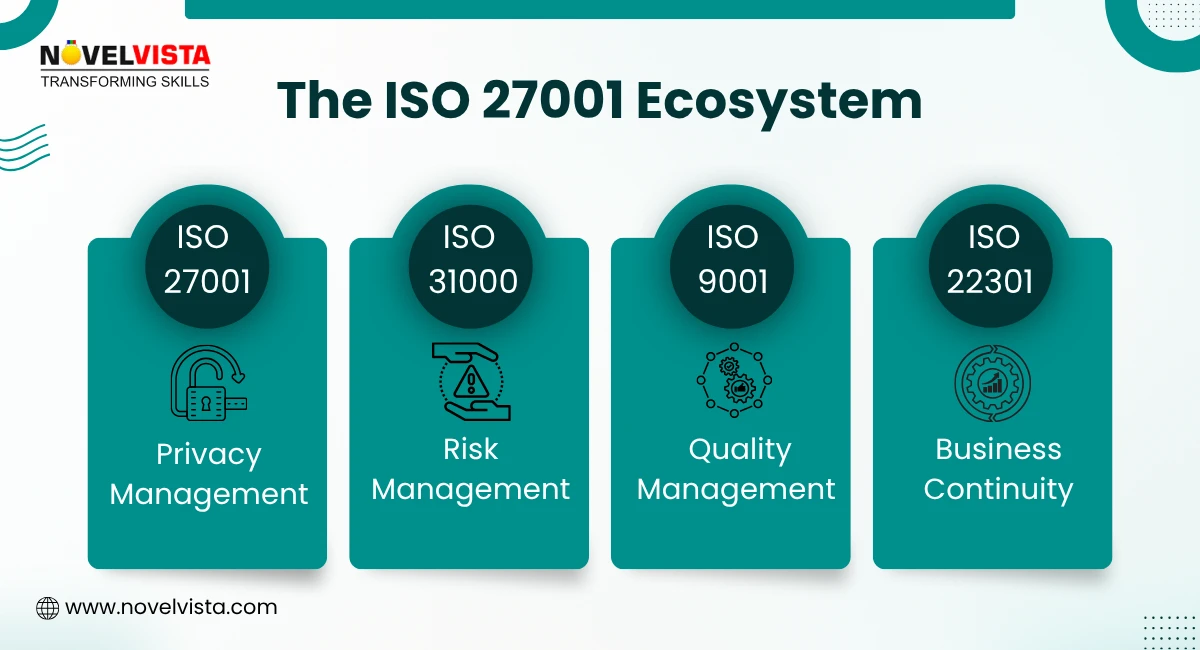
One of the strengths of the ISO 27001 framework is how seamlessly it integrates with other ISO frameworks.
Thanks to the Annex SL structure, it shares a common management system language with standards like:
- ISO 9001 (Quality Management)
- ISO 22301 (Business Continuity Management)
- ISO 31000 (Risk Management)
- ISO 27701 (Privacy Information Management)
This means you can manage security, quality, and privacy under one umbrella, without redundant processes. For example, pairing ISO 27001 + ISO 27701 enhances your ability to handle both security and privacy risks, making compliance smoother and more efficient.
Such integration also streamlines audits, documentation, and continuous improvement cycles, saving time, reducing duplication, and strengthening organizational governance.
Implementation Challenges of the ISO 27001 Framework
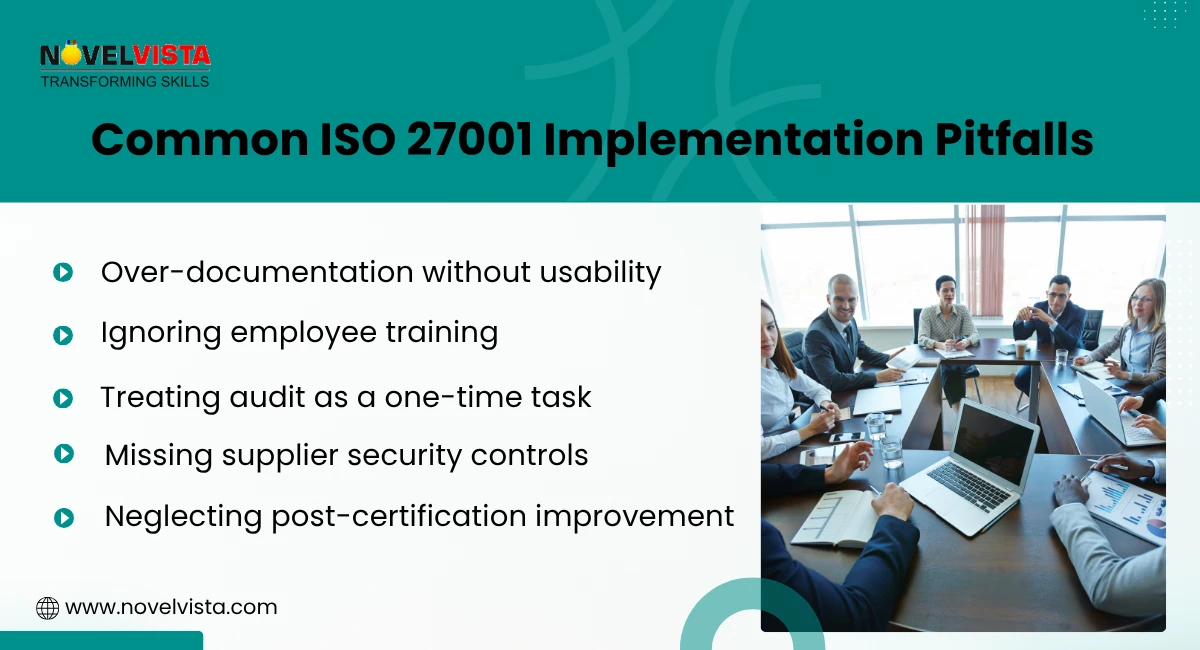
Implementing ISO 27001 is rewarding, but not without challenges. Many organizations stumble because they underestimate their depth and cross-departmental nature. Let’s break down a few common roadblocks:
- Lack of Leadership Commitment: Without executive sponsorship, ISO 27001 initiatives often lose momentum or funding midway.
- Incomplete Risk Assessments: Organizations sometimes treat risk analysis as a checklist activity rather than a living process, leading to blind spots in protection.
- Overcomplicated Documentation: Too much paperwork can overwhelm teams. The goal should be clarity and usability, not volume.
- Cultural Resistance: Security isn’t just a policy, it’s a behavior. Without staff awareness and buy-in, compliance remains superficial.
- Neglecting Continuous Improvement: Passing an audit isn’t the end. ISO 27001 expects ongoing evaluation and improvement as technologies and threats evolve.
Benefits of ISO 27001 Accreditation
When implemented right, ISO 27001 does much more than tick compliance boxes; it reshapes how your business thinks about security. Here’s what you gain:
- Improved Risk Management: Identify and mitigate vulnerabilities before they turn into incidents.
- Regulatory Compliance: Align with global standards and reduce legal and financial risks.
- Customer Confidence: ISO 27001-certified companies are seen as trustworthy partners that handle data responsibly.
- Business Continuity: Ensures resilience by preparing for cyberattacks, outages, or breaches.
- Operational Efficiency: Streamlined processes and reduced redundancies lower long-term costs.
- Competitive Edge: In tenders and global markets, ISO 27001 accreditation often becomes a key differentiator.
Essentially, ISO 27001 transforms security into a strategic business enabler, not just an IT responsibility.
Read More: Benefits of ISO 27001 Certification
Role and Pathway of ISO 27001 Lead Auditors
The Lead Auditor plays a pivotal role in ensuring that an organization’s ISMS aligns with ISO 27001 requirements. Their job isn’t just about checking documents; it’s about validating the real-world effectiveness of the security system.
Responsibilities of a Lead Auditor:
- Planning and conducting ISO 27001 audits.
- Identifying nonconformities and recommending improvements.
- Ensuring continual compliance and effectiveness of ISMS.
- Providing strategic advice on maintaining certification readiness.
Becoming a Lead Auditor:
- Learn the basics of ISO 27001: Study the standard (clauses, Annex A controls, and ISMS concepts) so you understand what an Information Security Management System requires.
- Gain practical experience with ISMS: Work on information security tasks, risk assessments, policy creation, incident handling, or ISMS operations, to see how the standard applies in real life.
- Build internal audit experience: Participate in or lead internal audits. Hands-on auditing shows you how to collect evidence, write findings, and verify corrective actions.
- Take a recognized Lead Auditor training course: Enroll in an accredited ISO 27001 Lead Auditor course that covers auditing techniques, audit planning, reporting, and ISO 27001 requirements.
- Pass the Lead Auditor exam: Complete the course assessments and pass the certification exam offered by the training body or an accredited certification organization.
- Complete required audit/working experience: Depending on the certifier, log a set number of audit days or supervised audit experience (often a mix of first-, second, or third-party audits).
- Apply for the ISO 27001 accreditation: Submit your training certificates, audit logs, and experience evidence to the certifying body to receive your Lead Auditor credential.
- Maintain competence and renew: Keep your skills current with continuing professional development (CPD), follow-up audits, and any recertification requirements from your certifier.
- Advance your auditing career: After certification, you can perform first-, second, and third-party audits, consult on ISMS implementation, or join certification bodies and audit teams.
Also Read: The Cost of ISO 27001 Certification
Conclusion
Firewalls, passwords, and antivirus software all matter, but they’re just pieces of the puzzle. The real foundation of lasting cybersecurity lies in a systematic, organization-wide framework that anticipates risks, manages them effectively, and constantly evolves with time. That’s what ISO 27001 brings to the table.
It isn’t just a compliance requirement, it’s a commitment to resilience. It aligns business goals with information protection, builds stakeholder trust, and empowers teams to make security an everyday practice.
In a landscape where one breach can undo years of reputation, ISO 27001 stands as your shield of credibility and control, proving that your organization doesn’t just talk about security, it lives it.
Next Step:
Advance Your Career with ISO 27001 accreditation. Get hands-on expertise in ISO 27001 implementation and auditing with NovelVista’s ISO 27001 Lead Auditor Certification Training. Learn to design, implement, and audit ISMS, ensuring your organization achieves compliance and data protection excellence.
Frequently Asked Questions
Author Details

Mr.Vikas Sharma
Principal Consultant
I am an Accredited ITIL, ITIL 4, ITIL 4 DITS, ITIL® 4 Strategic Leader, Certified SAFe Practice Consultant , SIAM Professional, PRINCE2 AGILE, Six Sigma Black Belt Trainer with more than 20 years of Industry experience. Working as SIAM consultant managing end-to-end accountability for the performance and delivery of IT services to the users and coordinating delivery, integration, and interoperability across multiple services and suppliers. Trained more than 10000+ participants under various ITSM, Agile & Project Management frameworks like ITIL, SAFe, SIAM, VeriSM, and PRINCE2, Scrum, DevOps, Cloud, etc.
Course Related To This blog
ISO 27001:2022 Lead Auditor
Confused About Certification?
Get Free Consultation Call

